Analyzing Crowdsourcing's Impact on the Sports Industry
VerifiedAdded on 2022/09/14
|9
|1855
|12
Report
AI Summary
This report delves into the potential impacts of crowdsourcing on the sports industry, exploring how technological innovation is reshaping various aspects, including equipment design, fan engagement, and business models. The report begins with an introduction to crowdsourcing, highlighting its increasing influence across different sectors, and emphasizes the role of technology in facilitating collective intelligence and collaboration. The research section covers the application of crowdsourcing in sports, such as leveraging audience insights for product development and promotional messaging. It explores how brands can utilize crowd intelligence to enhance team performance and improve stadium experiences. The report also addresses regulatory and ethical considerations that may limit the full potential of crowdsourcing, framed according to Lawrence Lessig's regulations. Furthermore, the report discusses the disruptive effects of crowdsourcing on sports processes, particularly in equipment design and manufacturing. The analysis includes a comparison of processes before and after the integration of crowdsourcing, demonstrating how brands can incorporate audience insights to create user-centric products, ultimately enhancing performance and brand value. The conclusion summarizes the key findings, emphasizing the significant changes that crowdsourcing can bring to the sports industry.
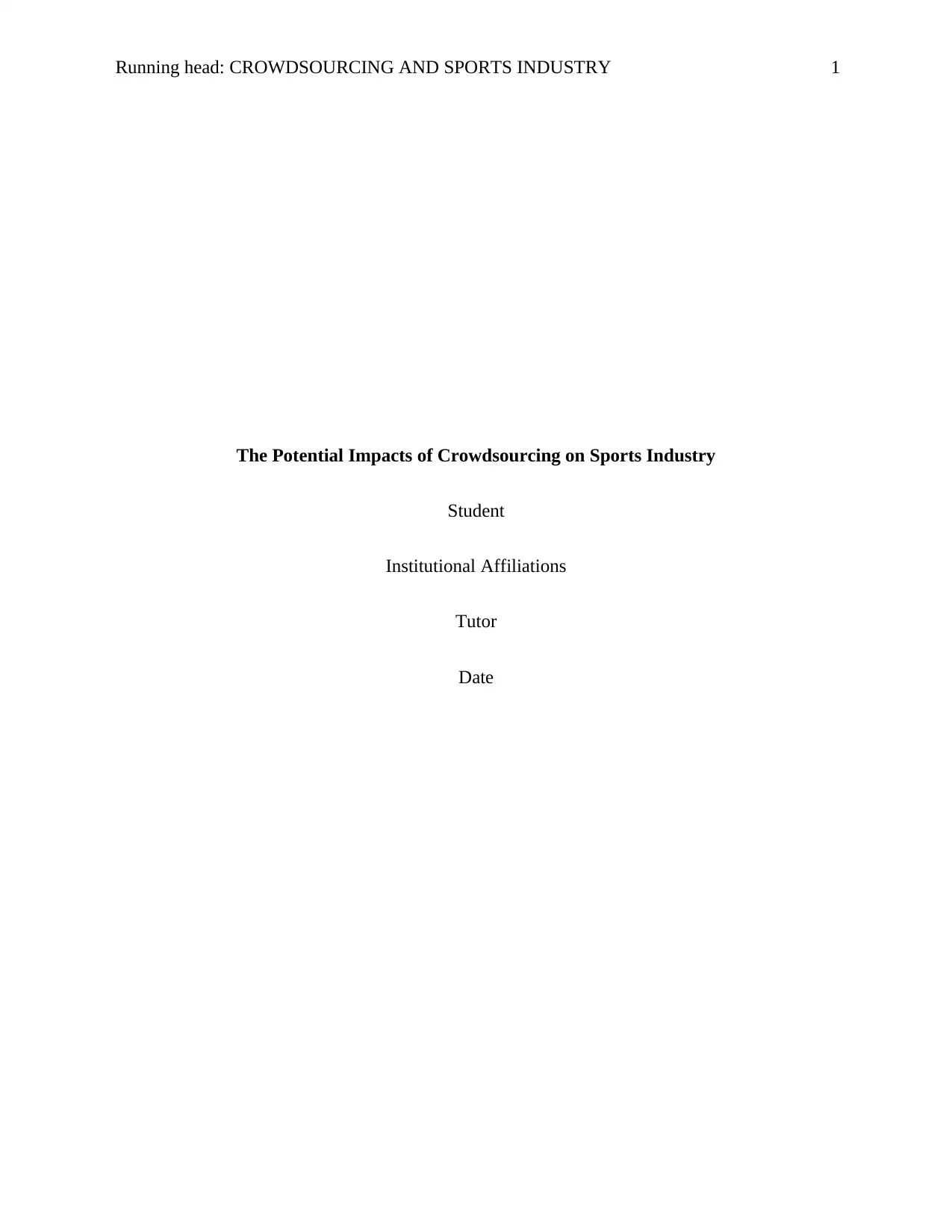
Running head: CROWDSOURCING AND SPORTS INDUSTRY 1
The Potential Impacts of Crowdsourcing on Sports Industry
Student
Institutional Affiliations
Tutor
Date
The Potential Impacts of Crowdsourcing on Sports Industry
Student
Institutional Affiliations
Tutor
Date
Paraphrase This Document
Need a fresh take? Get an instant paraphrase of this document with our AI Paraphraser
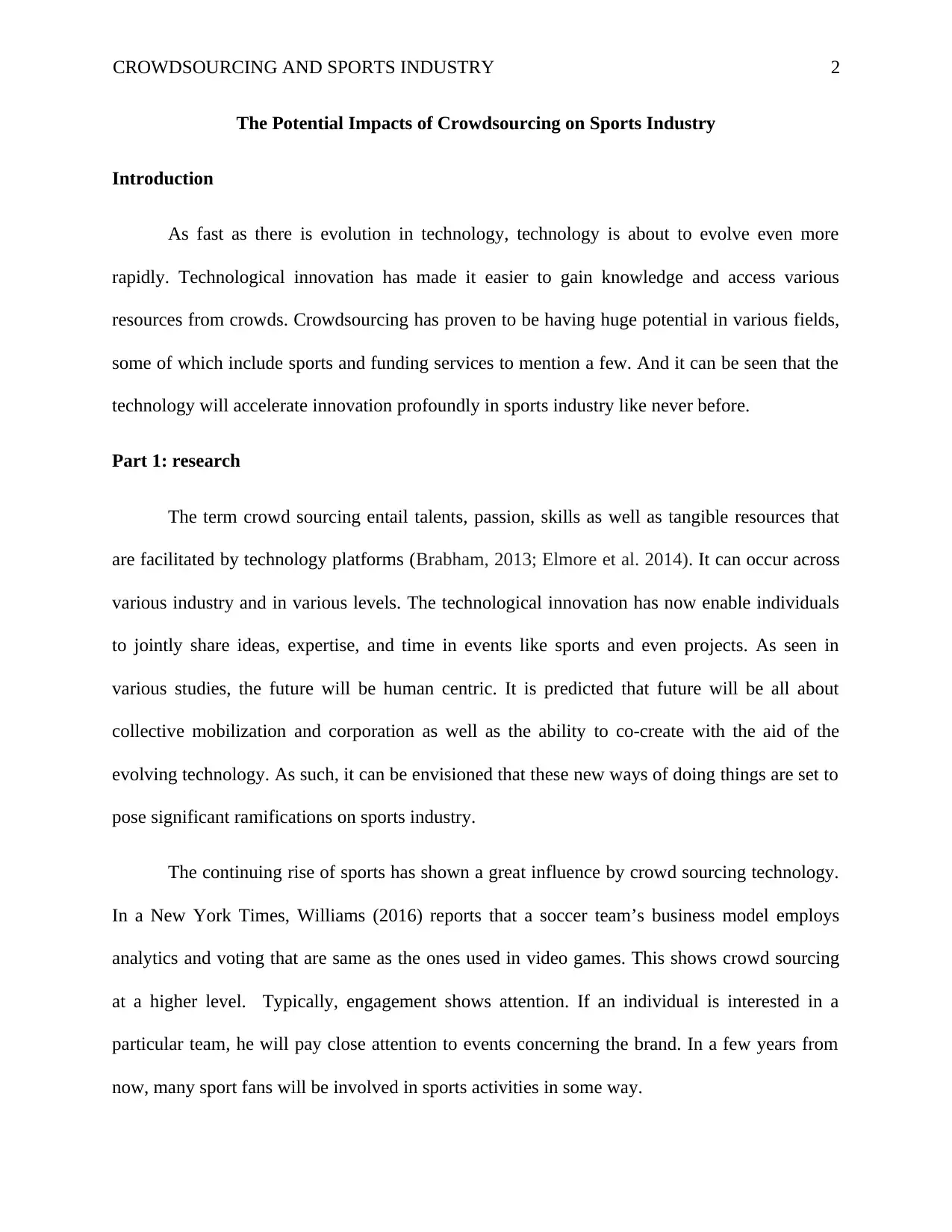
CROWDSOURCING AND SPORTS INDUSTRY 2
The Potential Impacts of Crowdsourcing on Sports Industry
Introduction
As fast as there is evolution in technology, technology is about to evolve even more
rapidly. Technological innovation has made it easier to gain knowledge and access various
resources from crowds. Crowdsourcing has proven to be having huge potential in various fields,
some of which include sports and funding services to mention a few. And it can be seen that the
technology will accelerate innovation profoundly in sports industry like never before.
Part 1: research
The term crowd sourcing entail talents, passion, skills as well as tangible resources that
are facilitated by technology platforms (Brabham, 2013; Elmore et al. 2014). It can occur across
various industry and in various levels. The technological innovation has now enable individuals
to jointly share ideas, expertise, and time in events like sports and even projects. As seen in
various studies, the future will be human centric. It is predicted that future will be all about
collective mobilization and corporation as well as the ability to co-create with the aid of the
evolving technology. As such, it can be envisioned that these new ways of doing things are set to
pose significant ramifications on sports industry.
The continuing rise of sports has shown a great influence by crowd sourcing technology.
In a New York Times, Williams (2016) reports that a soccer team’s business model employs
analytics and voting that are same as the ones used in video games. This shows crowd sourcing
at a higher level. Typically, engagement shows attention. If an individual is interested in a
particular team, he will pay close attention to events concerning the brand. In a few years from
now, many sport fans will be involved in sports activities in some way.
The Potential Impacts of Crowdsourcing on Sports Industry
Introduction
As fast as there is evolution in technology, technology is about to evolve even more
rapidly. Technological innovation has made it easier to gain knowledge and access various
resources from crowds. Crowdsourcing has proven to be having huge potential in various fields,
some of which include sports and funding services to mention a few. And it can be seen that the
technology will accelerate innovation profoundly in sports industry like never before.
Part 1: research
The term crowd sourcing entail talents, passion, skills as well as tangible resources that
are facilitated by technology platforms (Brabham, 2013; Elmore et al. 2014). It can occur across
various industry and in various levels. The technological innovation has now enable individuals
to jointly share ideas, expertise, and time in events like sports and even projects. As seen in
various studies, the future will be human centric. It is predicted that future will be all about
collective mobilization and corporation as well as the ability to co-create with the aid of the
evolving technology. As such, it can be envisioned that these new ways of doing things are set to
pose significant ramifications on sports industry.
The continuing rise of sports has shown a great influence by crowd sourcing technology.
In a New York Times, Williams (2016) reports that a soccer team’s business model employs
analytics and voting that are same as the ones used in video games. This shows crowd sourcing
at a higher level. Typically, engagement shows attention. If an individual is interested in a
particular team, he will pay close attention to events concerning the brand. In a few years from
now, many sport fans will be involved in sports activities in some way.
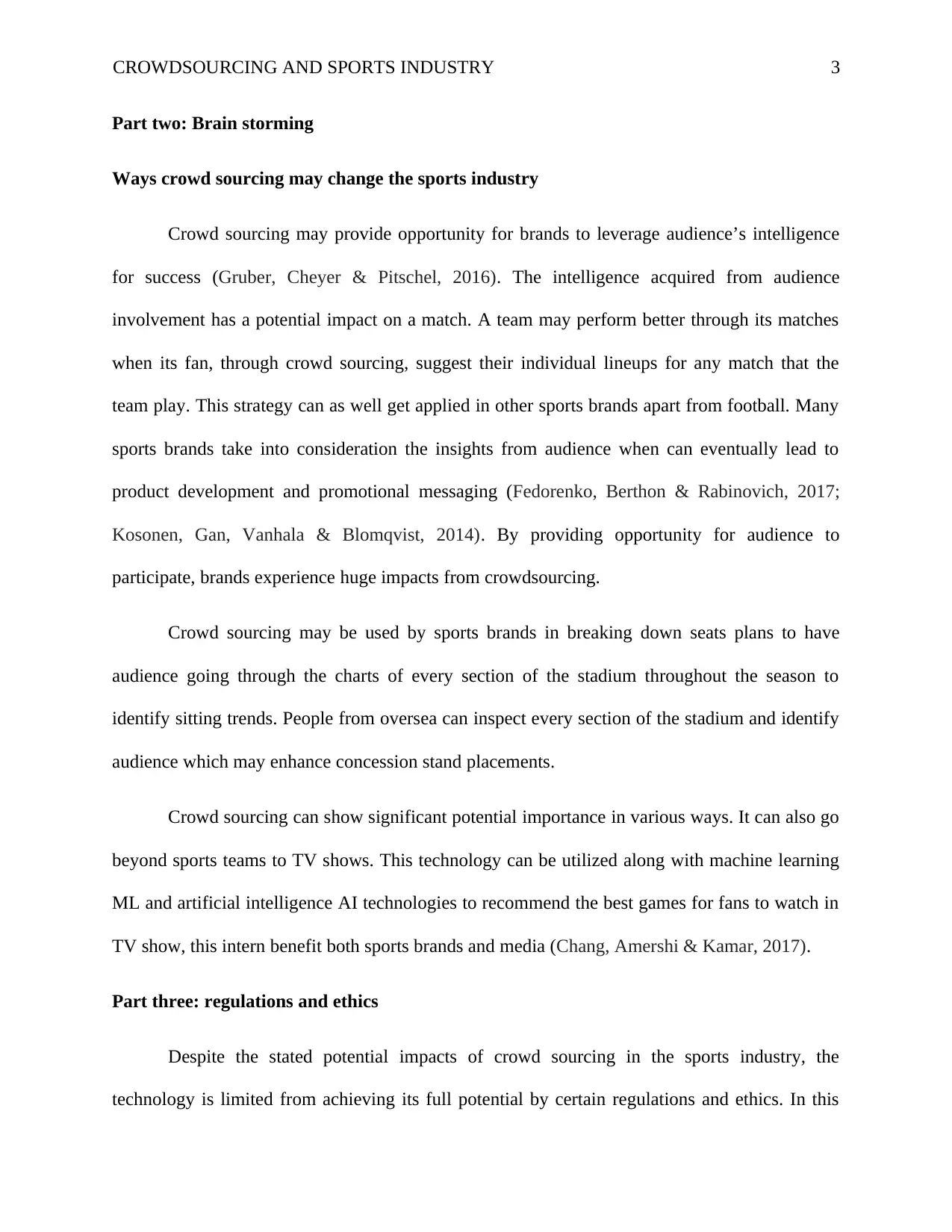
CROWDSOURCING AND SPORTS INDUSTRY 3
Part two: Brain storming
Ways crowd sourcing may change the sports industry
Crowd sourcing may provide opportunity for brands to leverage audience’s intelligence
for success (Gruber, Cheyer & Pitschel, 2016). The intelligence acquired from audience
involvement has a potential impact on a match. A team may perform better through its matches
when its fan, through crowd sourcing, suggest their individual lineups for any match that the
team play. This strategy can as well get applied in other sports brands apart from football. Many
sports brands take into consideration the insights from audience when can eventually lead to
product development and promotional messaging (Fedorenko, Berthon & Rabinovich, 2017;
Kosonen, Gan, Vanhala & Blomqvist, 2014). By providing opportunity for audience to
participate, brands experience huge impacts from crowdsourcing.
Crowd sourcing may be used by sports brands in breaking down seats plans to have
audience going through the charts of every section of the stadium throughout the season to
identify sitting trends. People from oversea can inspect every section of the stadium and identify
audience which may enhance concession stand placements.
Crowd sourcing can show significant potential importance in various ways. It can also go
beyond sports teams to TV shows. This technology can be utilized along with machine learning
ML and artificial intelligence AI technologies to recommend the best games for fans to watch in
TV show, this intern benefit both sports brands and media (Chang, Amershi & Kamar, 2017).
Part three: regulations and ethics
Despite the stated potential impacts of crowd sourcing in the sports industry, the
technology is limited from achieving its full potential by certain regulations and ethics. In this
Part two: Brain storming
Ways crowd sourcing may change the sports industry
Crowd sourcing may provide opportunity for brands to leverage audience’s intelligence
for success (Gruber, Cheyer & Pitschel, 2016). The intelligence acquired from audience
involvement has a potential impact on a match. A team may perform better through its matches
when its fan, through crowd sourcing, suggest their individual lineups for any match that the
team play. This strategy can as well get applied in other sports brands apart from football. Many
sports brands take into consideration the insights from audience when can eventually lead to
product development and promotional messaging (Fedorenko, Berthon & Rabinovich, 2017;
Kosonen, Gan, Vanhala & Blomqvist, 2014). By providing opportunity for audience to
participate, brands experience huge impacts from crowdsourcing.
Crowd sourcing may be used by sports brands in breaking down seats plans to have
audience going through the charts of every section of the stadium throughout the season to
identify sitting trends. People from oversea can inspect every section of the stadium and identify
audience which may enhance concession stand placements.
Crowd sourcing can show significant potential importance in various ways. It can also go
beyond sports teams to TV shows. This technology can be utilized along with machine learning
ML and artificial intelligence AI technologies to recommend the best games for fans to watch in
TV show, this intern benefit both sports brands and media (Chang, Amershi & Kamar, 2017).
Part three: regulations and ethics
Despite the stated potential impacts of crowd sourcing in the sports industry, the
technology is limited from achieving its full potential by certain regulations and ethics. In this
⊘ This is a preview!⊘
Do you want full access?
Subscribe today to unlock all pages.

Trusted by 1+ million students worldwide
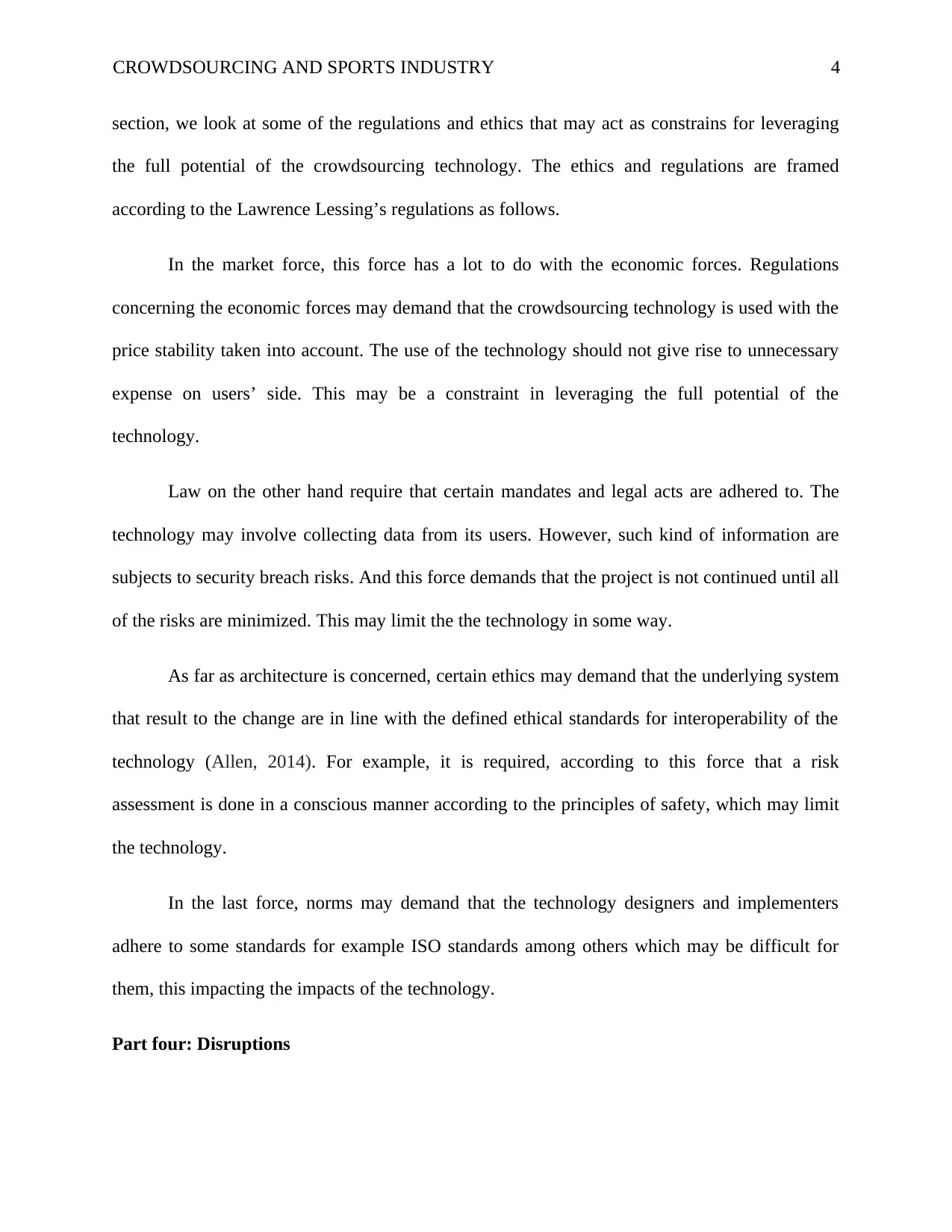
CROWDSOURCING AND SPORTS INDUSTRY 4
section, we look at some of the regulations and ethics that may act as constrains for leveraging
the full potential of the crowdsourcing technology. The ethics and regulations are framed
according to the Lawrence Lessing’s regulations as follows.
In the market force, this force has a lot to do with the economic forces. Regulations
concerning the economic forces may demand that the crowdsourcing technology is used with the
price stability taken into account. The use of the technology should not give rise to unnecessary
expense on users’ side. This may be a constraint in leveraging the full potential of the
technology.
Law on the other hand require that certain mandates and legal acts are adhered to. The
technology may involve collecting data from its users. However, such kind of information are
subjects to security breach risks. And this force demands that the project is not continued until all
of the risks are minimized. This may limit the the technology in some way.
As far as architecture is concerned, certain ethics may demand that the underlying system
that result to the change are in line with the defined ethical standards for interoperability of the
technology (Allen, 2014). For example, it is required, according to this force that a risk
assessment is done in a conscious manner according to the principles of safety, which may limit
the technology.
In the last force, norms may demand that the technology designers and implementers
adhere to some standards for example ISO standards among others which may be difficult for
them, this impacting the impacts of the technology.
Part four: Disruptions
section, we look at some of the regulations and ethics that may act as constrains for leveraging
the full potential of the crowdsourcing technology. The ethics and regulations are framed
according to the Lawrence Lessing’s regulations as follows.
In the market force, this force has a lot to do with the economic forces. Regulations
concerning the economic forces may demand that the crowdsourcing technology is used with the
price stability taken into account. The use of the technology should not give rise to unnecessary
expense on users’ side. This may be a constraint in leveraging the full potential of the
technology.
Law on the other hand require that certain mandates and legal acts are adhered to. The
technology may involve collecting data from its users. However, such kind of information are
subjects to security breach risks. And this force demands that the project is not continued until all
of the risks are minimized. This may limit the the technology in some way.
As far as architecture is concerned, certain ethics may demand that the underlying system
that result to the change are in line with the defined ethical standards for interoperability of the
technology (Allen, 2014). For example, it is required, according to this force that a risk
assessment is done in a conscious manner according to the principles of safety, which may limit
the technology.
In the last force, norms may demand that the technology designers and implementers
adhere to some standards for example ISO standards among others which may be difficult for
them, this impacting the impacts of the technology.
Part four: Disruptions
Paraphrase This Document
Need a fresh take? Get an instant paraphrase of this document with our AI Paraphraser
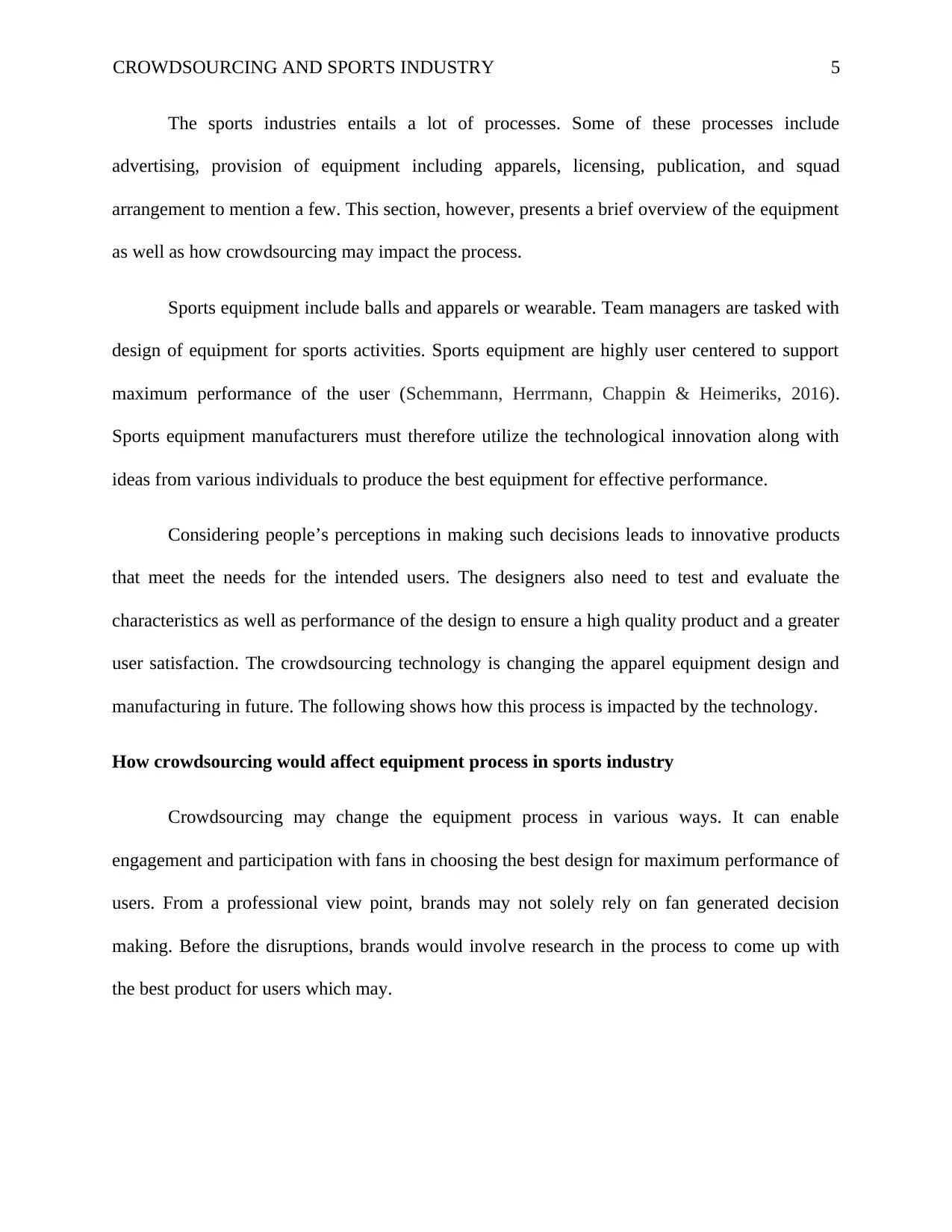
CROWDSOURCING AND SPORTS INDUSTRY 5
The sports industries entails a lot of processes. Some of these processes include
advertising, provision of equipment including apparels, licensing, publication, and squad
arrangement to mention a few. This section, however, presents a brief overview of the equipment
as well as how crowdsourcing may impact the process.
Sports equipment include balls and apparels or wearable. Team managers are tasked with
design of equipment for sports activities. Sports equipment are highly user centered to support
maximum performance of the user (Schemmann, Herrmann, Chappin & Heimeriks, 2016).
Sports equipment manufacturers must therefore utilize the technological innovation along with
ideas from various individuals to produce the best equipment for effective performance.
Considering people’s perceptions in making such decisions leads to innovative products
that meet the needs for the intended users. The designers also need to test and evaluate the
characteristics as well as performance of the design to ensure a high quality product and a greater
user satisfaction. The crowdsourcing technology is changing the apparel equipment design and
manufacturing in future. The following shows how this process is impacted by the technology.
How crowdsourcing would affect equipment process in sports industry
Crowdsourcing may change the equipment process in various ways. It can enable
engagement and participation with fans in choosing the best design for maximum performance of
users. From a professional view point, brands may not solely rely on fan generated decision
making. Before the disruptions, brands would involve research in the process to come up with
the best product for users which may.
The sports industries entails a lot of processes. Some of these processes include
advertising, provision of equipment including apparels, licensing, publication, and squad
arrangement to mention a few. This section, however, presents a brief overview of the equipment
as well as how crowdsourcing may impact the process.
Sports equipment include balls and apparels or wearable. Team managers are tasked with
design of equipment for sports activities. Sports equipment are highly user centered to support
maximum performance of the user (Schemmann, Herrmann, Chappin & Heimeriks, 2016).
Sports equipment manufacturers must therefore utilize the technological innovation along with
ideas from various individuals to produce the best equipment for effective performance.
Considering people’s perceptions in making such decisions leads to innovative products
that meet the needs for the intended users. The designers also need to test and evaluate the
characteristics as well as performance of the design to ensure a high quality product and a greater
user satisfaction. The crowdsourcing technology is changing the apparel equipment design and
manufacturing in future. The following shows how this process is impacted by the technology.
How crowdsourcing would affect equipment process in sports industry
Crowdsourcing may change the equipment process in various ways. It can enable
engagement and participation with fans in choosing the best design for maximum performance of
users. From a professional view point, brands may not solely rely on fan generated decision
making. Before the disruptions, brands would involve research in the process to come up with
the best product for users which may.
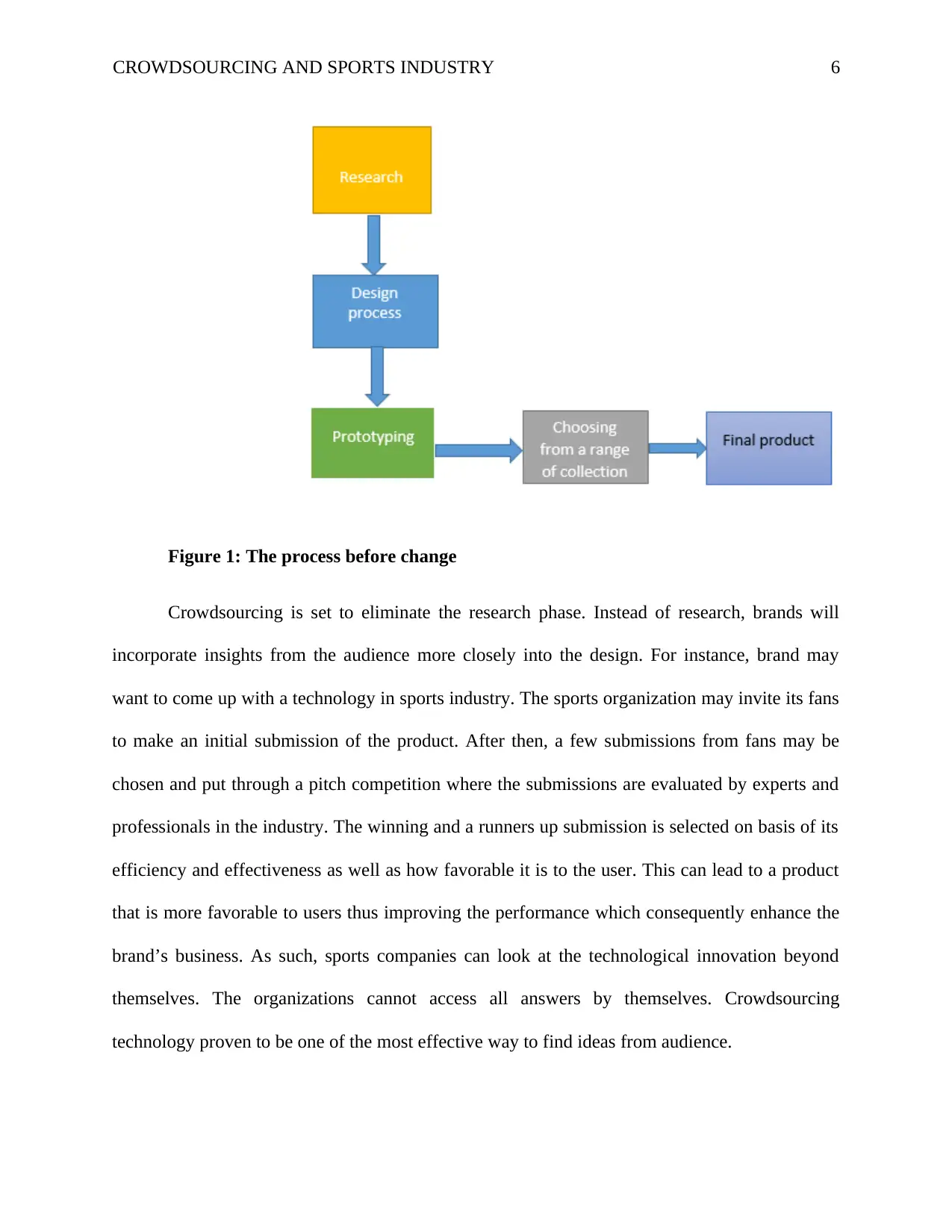
CROWDSOURCING AND SPORTS INDUSTRY 6
Figure 1: The process before change
Crowdsourcing is set to eliminate the research phase. Instead of research, brands will
incorporate insights from the audience more closely into the design. For instance, brand may
want to come up with a technology in sports industry. The sports organization may invite its fans
to make an initial submission of the product. After then, a few submissions from fans may be
chosen and put through a pitch competition where the submissions are evaluated by experts and
professionals in the industry. The winning and a runners up submission is selected on basis of its
efficiency and effectiveness as well as how favorable it is to the user. This can lead to a product
that is more favorable to users thus improving the performance which consequently enhance the
brand’s business. As such, sports companies can look at the technological innovation beyond
themselves. The organizations cannot access all answers by themselves. Crowdsourcing
technology proven to be one of the most effective way to find ideas from audience.
Figure 1: The process before change
Crowdsourcing is set to eliminate the research phase. Instead of research, brands will
incorporate insights from the audience more closely into the design. For instance, brand may
want to come up with a technology in sports industry. The sports organization may invite its fans
to make an initial submission of the product. After then, a few submissions from fans may be
chosen and put through a pitch competition where the submissions are evaluated by experts and
professionals in the industry. The winning and a runners up submission is selected on basis of its
efficiency and effectiveness as well as how favorable it is to the user. This can lead to a product
that is more favorable to users thus improving the performance which consequently enhance the
brand’s business. As such, sports companies can look at the technological innovation beyond
themselves. The organizations cannot access all answers by themselves. Crowdsourcing
technology proven to be one of the most effective way to find ideas from audience.
⊘ This is a preview!⊘
Do you want full access?
Subscribe today to unlock all pages.

Trusted by 1+ million students worldwide
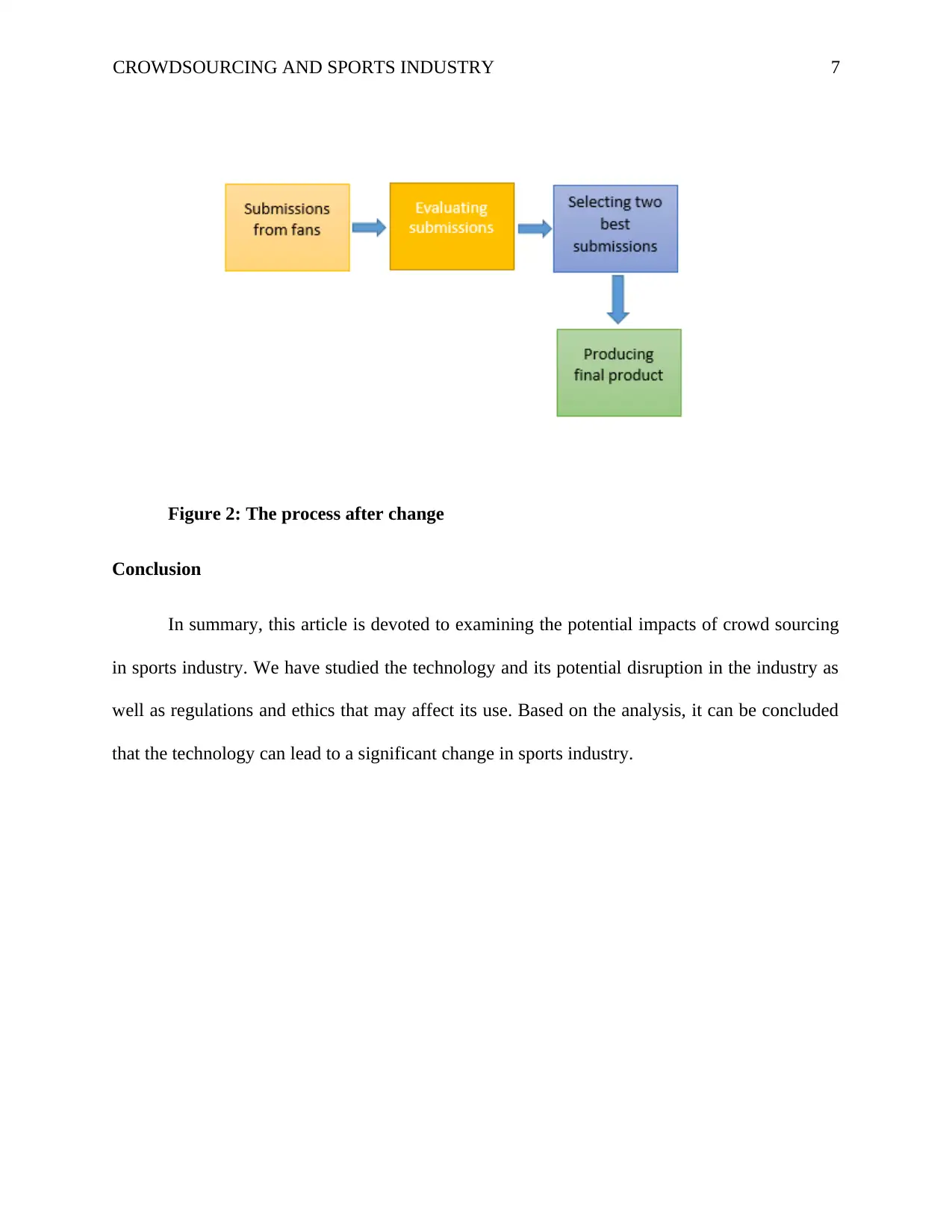
CROWDSOURCING AND SPORTS INDUSTRY 7
Figure 2: The process after change
Conclusion
In summary, this article is devoted to examining the potential impacts of crowd sourcing
in sports industry. We have studied the technology and its potential disruption in the industry as
well as regulations and ethics that may affect its use. Based on the analysis, it can be concluded
that the technology can lead to a significant change in sports industry.
Figure 2: The process after change
Conclusion
In summary, this article is devoted to examining the potential impacts of crowd sourcing
in sports industry. We have studied the technology and its potential disruption in the industry as
well as regulations and ethics that may affect its use. Based on the analysis, it can be concluded
that the technology can lead to a significant change in sports industry.
Paraphrase This Document
Need a fresh take? Get an instant paraphrase of this document with our AI Paraphraser
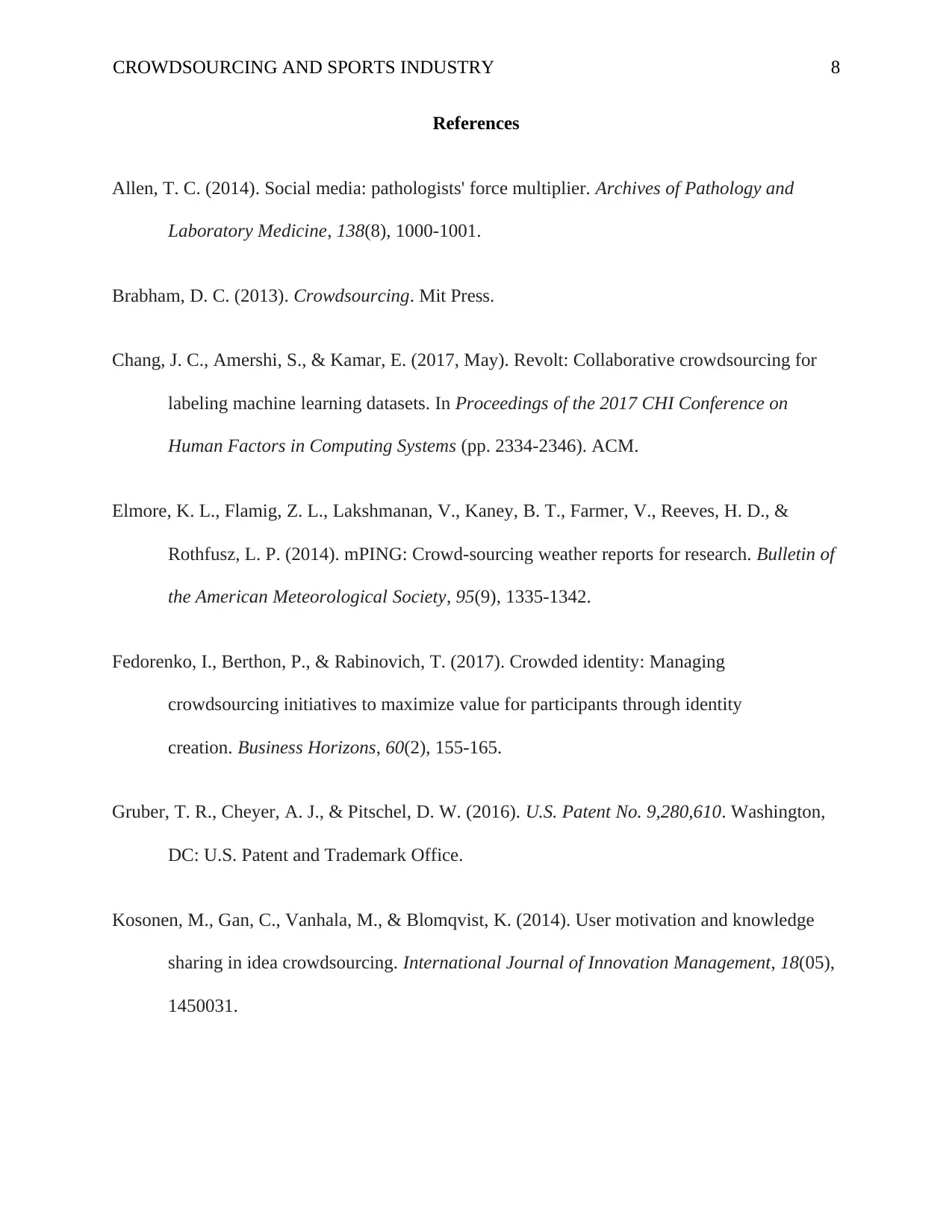
CROWDSOURCING AND SPORTS INDUSTRY 8
References
Allen, T. C. (2014). Social media: pathologists' force multiplier. Archives of Pathology and
Laboratory Medicine, 138(8), 1000-1001.
Brabham, D. C. (2013). Crowdsourcing. Mit Press.
Chang, J. C., Amershi, S., & Kamar, E. (2017, May). Revolt: Collaborative crowdsourcing for
labeling machine learning datasets. In Proceedings of the 2017 CHI Conference on
Human Factors in Computing Systems (pp. 2334-2346). ACM.
Elmore, K. L., Flamig, Z. L., Lakshmanan, V., Kaney, B. T., Farmer, V., Reeves, H. D., &
Rothfusz, L. P. (2014). mPING: Crowd-sourcing weather reports for research. Bulletin of
the American Meteorological Society, 95(9), 1335-1342.
Fedorenko, I., Berthon, P., & Rabinovich, T. (2017). Crowded identity: Managing
crowdsourcing initiatives to maximize value for participants through identity
creation. Business Horizons, 60(2), 155-165.
Gruber, T. R., Cheyer, A. J., & Pitschel, D. W. (2016). U.S. Patent No. 9,280,610. Washington,
DC: U.S. Patent and Trademark Office.
Kosonen, M., Gan, C., Vanhala, M., & Blomqvist, K. (2014). User motivation and knowledge
sharing in idea crowdsourcing. International Journal of Innovation Management, 18(05),
1450031.
References
Allen, T. C. (2014). Social media: pathologists' force multiplier. Archives of Pathology and
Laboratory Medicine, 138(8), 1000-1001.
Brabham, D. C. (2013). Crowdsourcing. Mit Press.
Chang, J. C., Amershi, S., & Kamar, E. (2017, May). Revolt: Collaborative crowdsourcing for
labeling machine learning datasets. In Proceedings of the 2017 CHI Conference on
Human Factors in Computing Systems (pp. 2334-2346). ACM.
Elmore, K. L., Flamig, Z. L., Lakshmanan, V., Kaney, B. T., Farmer, V., Reeves, H. D., &
Rothfusz, L. P. (2014). mPING: Crowd-sourcing weather reports for research. Bulletin of
the American Meteorological Society, 95(9), 1335-1342.
Fedorenko, I., Berthon, P., & Rabinovich, T. (2017). Crowded identity: Managing
crowdsourcing initiatives to maximize value for participants through identity
creation. Business Horizons, 60(2), 155-165.
Gruber, T. R., Cheyer, A. J., & Pitschel, D. W. (2016). U.S. Patent No. 9,280,610. Washington,
DC: U.S. Patent and Trademark Office.
Kosonen, M., Gan, C., Vanhala, M., & Blomqvist, K. (2014). User motivation and knowledge
sharing in idea crowdsourcing. International Journal of Innovation Management, 18(05),
1450031.
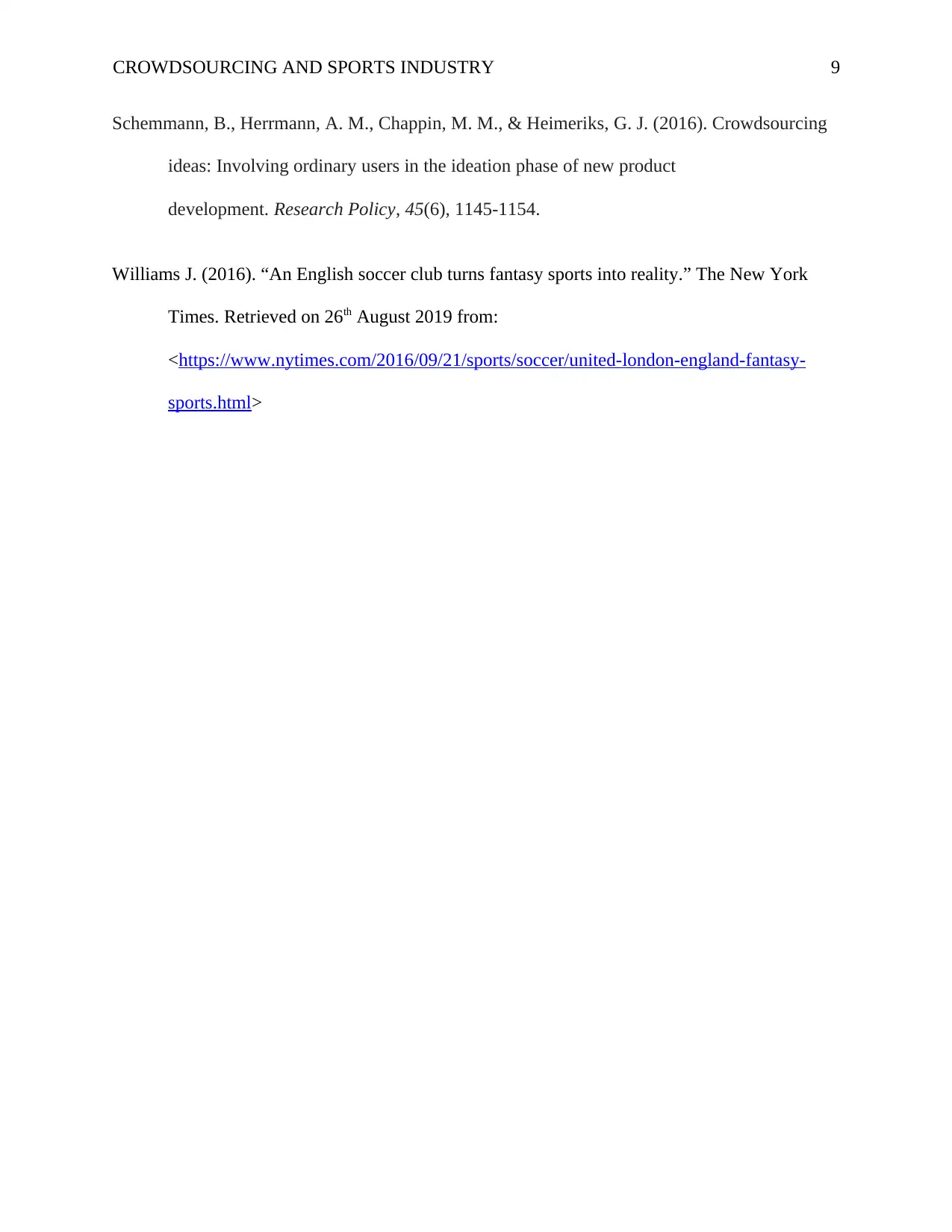
CROWDSOURCING AND SPORTS INDUSTRY 9
Schemmann, B., Herrmann, A. M., Chappin, M. M., & Heimeriks, G. J. (2016). Crowdsourcing
ideas: Involving ordinary users in the ideation phase of new product
development. Research Policy, 45(6), 1145-1154.
Williams J. (2016). “An English soccer club turns fantasy sports into reality.” The New York
Times. Retrieved on 26th August 2019 from:
<https://www.nytimes.com/2016/09/21/sports/soccer/united-london-england-fantasy-
sports.html>
Schemmann, B., Herrmann, A. M., Chappin, M. M., & Heimeriks, G. J. (2016). Crowdsourcing
ideas: Involving ordinary users in the ideation phase of new product
development. Research Policy, 45(6), 1145-1154.
Williams J. (2016). “An English soccer club turns fantasy sports into reality.” The New York
Times. Retrieved on 26th August 2019 from:
<https://www.nytimes.com/2016/09/21/sports/soccer/united-london-england-fantasy-
sports.html>
⊘ This is a preview!⊘
Do you want full access?
Subscribe today to unlock all pages.

Trusted by 1+ million students worldwide
1 out of 9
Related Documents
Your All-in-One AI-Powered Toolkit for Academic Success.
+13062052269
info@desklib.com
Available 24*7 on WhatsApp / Email
![[object Object]](/_next/static/media/star-bottom.7253800d.svg)
Unlock your academic potential
Copyright © 2020–2025 A2Z Services. All Rights Reserved. Developed and managed by ZUCOL.





